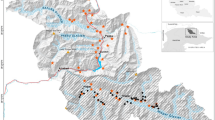Abstract
Conservation and management agencies require accurate and precise estimates of abundance when considering the status of a species and the need for directed actions. Due to the proliferation of remote sampling cameras, there has been an increase in capture–recapture studies that estimate the abundance of rare and/or elusive species using closed capture–recapture estimators (C–R). However, data from these studies often do not meet necessary statistical assumptions. Common attributes of these data are (1) infrequent detections, (2) a small number of individuals detected, (3) long survey durations, and (4) variability in detection among individuals. We believe there is a need for guidance when analyzing this type of sparse data. We highlight statistical limitations of closed C–R estimators when data are sparse and suggest an alternative approach over the conventional use of the Jackknife estimator. Our approach aims to maximize the probability individuals are detected at least once over the entire sampling period, thus making the modeling of variability in the detection process irrelevant, estimating abundance accurately and precisely. We use simulations to demonstrate when using the unconditional-likelihood M 0 (constant detection probability) closed C–R estimator with profile-likelihood confidence intervals provides reliable results even when detection varies by individual. If each individual in the population is detected on average of at least 2.5 times, abundance estimates are accurate and precise. When studies sample the same species at multiple areas or at the same area over time, we suggest sharing detection information across datasets to increase precision when estimating abundance. The approach suggested here should be useful for monitoring small populations of species that are difficult to detect.



Similar content being viewed by others
References
Bates DM, Watts DG (1980) Relative curvature measures of nonlinearity. J R Stat Soc B 42:1–25
Borchers DL, Buckland ST, Zucchini W (2002) Estimating animal abundance: closed populations. Springer Verlag, New York
Boulanger J, White GC, McLellan BN, Woods J, Proctor M, Himmer S (2002) A meta-analysis of grizzly bear DNA mark-recapture projects in British Columbia, Canada: invited paper. Ursus 13:137–152
Bowden DC, White GC, Franklin AB, Ganey JL (2003) Estimating population size with correlated sampling unit estimates. J Wildl Manag 67:1–10
Burnham KP, Anderson DR (2002) Model selection and multimodel inference: a practical information-theoretic approach. Springer-Verlag, New York
Burnham KP, Overton WS (1978) Estimation of the size of a closed population when capture probabilities vary among animals. Biometrika 65:625–633
Chao A, Huggins RM (2005) Modern closed-population capture–recapture models. In: Amstrup SC, McDonald TL, Manly BFJ (eds) Handbook of capture–recapture analysis. Princeton University Press, Princeton, pp 58–86
Conn PB, Arthur AD, Bailey LL, Singleton GR (2006) Estimating the abundance of mouse populations of known size: promises and pitfalls of new methods. Ecol Appl 16:829–837
Donaldson JR, Schnabel RB (1987) Computational experience with confidence regions and confidence intervals for nonlinear least squares. Technometrics 29:67–82
Efford M (2011) SECR: spatially explicit capture–recapture models. R Packag Vers 2(3):1
Efford MG, Fewster RM (2013) Estimating population size by spatially explicit capture–recapture. Oikos 122:918–928
Efford M, Dawson D, Robbins C (2004) DENSITY: software for analysing capture–recapture data from passive detector arrays. Anim Biodivers Conserv 27:217–228
Foster RJ, Harmsen BJ (2012) A critique of density estimation from camera-trap data. J Wildl Manag 76:224–236
Gerber BD, Karpanty SM, Randrianantenaina J (2012) The impact of forest logging and fragmentation on carnivore species composition, density and occupancy in Madagascar’s rainforests. Oryx 46:414–422
Harmsen B, Foster R, Doncaster C (2011) Heterogeneous capture rates in low density populations and consequences for capture–recapture analysis of camera-trap data. Popul Ecol 53:253–259
Hudson DJ (1971) Interval estimation from the likelihood function. J R Stat Soc B 33:256–262
Huggins RM (1991) Some practical aspects of a conditional likelihood approach to capture experiments. Biometrics 47:725–732
Ivan J, White GC, Shenk TM (2013) Using simulation to compare methods for estimating density from capture–recapture data. Ecology 94:817–826
Jackson RM, Roe JD, Wangchuk R, Hunter DO (2006) Estimating snow leopard population abundance using photography and capture–recapture techniques. Wildl Soc Bull 34:772–781
Karanth KU, Nichols JD (1998) Estimation of tiger densities in India using photographic captures and recaptures. Ecology 79:2852–2862
Karanth KU, Nichols JD (2002) Monitoring tigers and their prey: a manual for researchers, managers and conservationists in tropical Asia. Centre for Wildlife Studies, Banglamore
Kendall WL (1999) Robustness of closed capture–recapture methods to violations of the closure assumption. Ecology 80:2517–2525
Laake JL (2013) RMark: an R interface for analysis of capture–recapture data with MARK. Alaska Fisheries Science Center, NOAA, National Marine Fisheries Service, Alaska
Noyce KV, Garshelis DL, Coy PL (2001) Differential vulnerability of black bears to trap and camera sampling and resulting biases in mark-recapture estimates. Ursus 12:211–225
O’Connell AF, Nichols JD, Karanth UK (2010) Camera traps in animal ecology: methods and analyses. Springer Verlag, New York
Pledger S (2000) Unified maximum likelihood estimates for closed capture–recapture models using mixtures. Biometrics 56:434–442
Rexstad E, Burnham KP (1991) Users guide for interactive program CAPTURE abundance estimation of closed population animal populations. Colorado State University, Fort Collins
Royle JA, Chandler RB, Sollmann R, Gardner B (2013) Spatial capture–recapture. Academic Press, Salt Lake City
Venzon DJ, Moolgavkar SH (1988) A method for computing profile-likelihood-based confidence intervals. J Roy Statist Soc C 37:87–94
Walther BA, Morand S (1998) Comparative performance of species richness estimation methods. Parasitology 116:395–405
Wasser SK, Davenport B, Ramage ER, Hunt KE, Parker M, Clarke C, Stenhouse G (2004) Scat detection dogs in wildlife research and management: application to grizzly and black bears in the Yellowhead Ecosystem, Alberta, Canada. Can J Zool 82:475–492
White C (2005) Correcting wildlife counts using detection probabilities. Wildl Res 32:211–216
White GC, Burnham KP (1999) Program MARK: survival estimation from populations of marked animals. Bird Study 46:S120–S138
White GC, Anderson DR, Burnham KP, Otis DL (1982) Capture–recapture and removal methods for sampling closed populations. Los Alamos National Laboratory, Los Alamos
Acknowledgments
We thank S. Karpanty and D. Catlin for early discussions on this topic, G. White for taking the time to answer questions throughout the development of this research, and Sunarto for inspiring this work. We are grateful to reviewers that helped clarify this manuscript.
Author information
Authors and Affiliations
Corresponding author
Electronic supplementary material
Below is the link to the electronic supplementary material.
Rights and permissions
About this article
Cite this article
Gerber, B.D., Ivan, J.S. & Burnham, K.P. Estimating the abundance of rare and elusive carnivores from photographic-sampling data when the population size is very small. Popul Ecol 56, 463–470 (2014). https://doi.org/10.1007/s10144-014-0431-8
Received:
Accepted:
Published:
Issue Date:
DOI: https://doi.org/10.1007/s10144-014-0431-8




